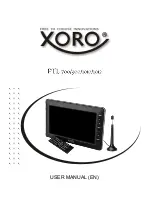
TP0332/2
3.15
-
EXT_LSA, EXT_LSB
The bridged audio loudspeaker outputs are capable of delivering 500mW into a 16
Ω
load.
-
MIC1
The combined accessory detect and audio input line MIC1 allows the radio to detect what type of
ancillary is connected and the ancillary status (such as key presses). Each ancillary has a ‘type’ resistor
that sets up a unique voltage on this accessory detect line which is monitored by the comparator formed by
IC801_A and its associated components. The exception to this is the User Memory Plug (UMP) which
does not have a type resistor but is detected via the IIC lines. The processor reads the accessory detect
voltage via KEY_DET1. If the accessory detect voltage is below the threshold set by R823, R824 and
R825, a processor interrupt is generated on PTT1. The ancillary may superimpose audio on to the d.c.
level on MIC1 which gets routed to the baseband chip IC701. The input to the accessory detect
comparator IC801_A is filtered by R803/C802 to prevent any speech signal on the accessory detect line
affecting the accessory detection process.
RS232/IIC Serial Communications
The combined RS232 and IIC lines allow serial communication with external RS232 devices such as
the SRP8000 programmer, or external IIC devices such as a User Memory Plug.
The RXD1_IN line can accept an RS232 input signal which is typically ±10V in amplitude or an IIC
data input signal which is 0 to +5V in amplitude. Either type of input signal is inverted and converted to a
0 to +2,5V signal on RXD1 by TR804 and passed to the processor.
The RXD1_IN line can also be used as an open-collector output for IIC data. In this case, the
processor drives the RXD1 port pin as an output which gets inverted by comparator IC801_B. When RXD1
is driven high, the comparator pulls RXD1_IN low via D801. When RXD1 is driven low, the comparator
output turns off allowing R814 to pull the RXD1_IN output to +5V. TR804 plays no part when RXD1 is used
as an output.
The processor UART transmit signal TXD1 is inverted and converted to a 0 to +5V RS232 signal by
TR806 to TR808 and TR801 to TR803. Although the RS232 specification technically requires a minimum
voltage swing of ±5V, in practice modern RS232 receivers work on a 0 to +5V input voltage swing. An
external device may be powered from the smart interface TXD1_OUT line when this output is set to +5V.
The output is current limited to 50mA by TR802 and R808 with R808 sensing the output current drawn.
The TXD1_OUT line can also be used as an IIC clock driver. The operation of the driver is no
different from the RS232 case.
The RXD1_IN line can also be used to trickle charge the radio battery when a voltage greater than
the battery voltage is applied.
Loudspeaker / Microphone Flexi Connector
Table 3.5 Loudspeaker/Microphone Connector Signal Names and Usage
PTT and Side Key Press Detection
PTT, Sidekey 1, Sidekey 2, Alarm and MMI keypad key presses are detected by use of the
processor interrupt line PTT3 and the processor ADC input KEY_DET3.
Normally, with no key pressed, KEY_DET3 voltage sits at 0V due to the 10k
Ω
pull-down resistor
R15. Pressing any key takes the KEY_DET3 voltage above the reference set by resistors R13 and R16.
Comparator IC207_A then generates a PTT3 processor interrupt which informs the processor that a key
has been pressed. Each key is arranged to generate a different KEY_DET3 voltage which is how the
processor determines which key is pressed.
Signal Name
Use
Signal Type
Direction
MIC2
Microphone input
Nominally 3V DC
To baseband
0VA
Battery ground
0V
To flexi
INT_LS2A
INT_LS2B
Internal speaker
Balanced audio
3,5V nominal
To flexi
Summary of Contents for SRP8000 SERIES
Page 1: ...SERVICE MANUAL TP0332 2 SRP8000 SERIES VHF UHF PORTABLE RADIO...
Page 55: ...TP0332 2 6 5 Figure 6 4 Radio PCB Component Layout Diagram Side 2 MAIN ASSEMBLY SIDE 2 BOTTOM...
Page 57: ...TP0332 2 6 7 Figure 6 6 Radio PCB Circuit Diagram...
Page 58: ...6 8 TP0332 2 Figure 6 7 Power Supplies Circuit Diagram...
Page 59: ...TP0332 2 6 9 Figure 6 8 Receiver Circuit Diagram...
Page 61: ...TP0332 2 6 11 Figure 6 10 Frequency Generation Circuit Diagram...
Page 62: ...6 12 TP0332 2 Figure 6 11 Baseband Circuit Diagram...
Page 63: ...TP0332 2 6 13 Figure 6 12 Control Circuit Diagram...
Page 64: ...6 14 TP0332 2 Figure 6 13 SMART Interface Circuit Diagram...
Page 67: ...TP0332 2 6 17 Figure 6 16 MMI PCB Circuit Diagram...
Page 75: ...TP0332 2 B 3 PARTS LIST Description Part No Remarks Lapel LS Mic complete 0000 242 10001...
















































